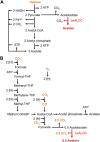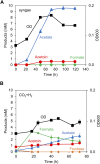Genetic engineering of a thermophilic acetogen, Moorella thermoacetica Y72, to enable acetoin production
- PMID: 38812916
- PMCID: PMC11133584
- DOI: 10.3389/fbioe.2024.1398467
Genetic engineering of a thermophilic acetogen, Moorella thermoacetica Y72, to enable acetoin production
Abstract
Acetogens are among the key microorganisms involved in the bioproduction of commodity chemicals from diverse carbon resources, such as biomass and waste gas. Thermophilic acetogens are particularly attractive because fermentation at higher temperatures offers multiple advantages. However, the main target product is acetic acid. Therefore, it is necessary to reshape metabolism using genetic engineering to produce the desired chemicals with varied carbon lengths. Although such metabolic engineering has been hampered by the difficulty involved in genetic modification, a model thermophilic acetogen, M. thermoacetica ATCC 39073, is the case with a few successful cases of C2 and C3 compound production, other than acetate. This brief report attempts to expand the product spectrum to include C4 compounds by using strain Y72 of Moorella thermoacetica. Strain Y72 is a strain related to the type strain ATCC 39073 and has been reported to have a less stringent restriction-modification system, which could alleviate the cumbersome transformation process. A simplified procedure successfully introduced a key enzyme for acetoin (a C4 chemical) production, and the resulting strains produced acetoin from sugars and gaseous substrates. The culture profile revealed varied acetoin yields depending on the type of substrate and culture conditions, implying the need for further engineering in the future. Thus, the use of a user-friendly chassis could benefit the genetic engineering of M. thermoacetica.
Keywords: C4 chemicals; acetoin; biomass; gaseous substrates; genetic engineering; thermophilic acetogen.
Copyright © 2024 Kato, Fujii, Kato, Wada, Watanabe, Nakamichi, Aoi, Morita, Murakami and Nakashimada.
Conflict of interest statement
This work has been included in a patent application by Hiroshima University and AIST.
Figures




Similar articles
-
Isopropanol production via the thermophilic bioconversion of sugars and syngas using metabolically engineered Moorella thermoacetica.Biotechnol Biofuels Bioprod. 2024 Jan 28;17(1):13. doi: 10.1186/s13068-024-02460-1. Biotechnol Biofuels Bioprod. 2024. PMID: 38281982 Free PMC article.
-
Metabolic engineering of Moorella thermoacetica for thermophilic bioconversion of gaseous substrates to a volatile chemical.AMB Express. 2021 Apr 23;11(1):59. doi: 10.1186/s13568-021-01220-w. AMB Express. 2021. PMID: 33891189 Free PMC article.
-
Genome-guided analysis of transformation efficiency and carbon dioxide assimilation by Moorella thermoacetica Y72.Gene. 2014 Feb 10;535(2):150-5. doi: 10.1016/j.gene.2013.11.045. Epub 2013 Dec 6. Gene. 2014. PMID: 24316126
-
Thermophilic Moorella thermoacetica as a platform microorganism for C1 gas utilization: physiology, engineering, and applications.Bioresour Bioprocess. 2023 Sep 15;10(1):61. doi: 10.1186/s40643-023-00682-z. Bioresour Bioprocess. 2023. PMID: 38647965 Free PMC article. Review.
-
Progresses and challenges of engineering thermophilic acetogenic cell factories.Front Microbiol. 2024 Aug 30;15:1476253. doi: 10.3389/fmicb.2024.1476253. eCollection 2024. Front Microbiol. 2024. PMID: 39282569 Free PMC article. Review.
References
-
- Abdel-Banat B. M., Hoshida H., Ano A., Nonklang S., Akada R. (2010). High-temperature fermentation: how can processes for ethanol production at high temperatures become superior to the traditional process using mesophilic yeast? Appl. Microbiol. Biotechnol. 85, 861–867. 10.1007/s00253-009-2248-5 - DOI - PubMed
LinkOut - more resources
Full Text Sources
Molecular Biology Databases
Miscellaneous

